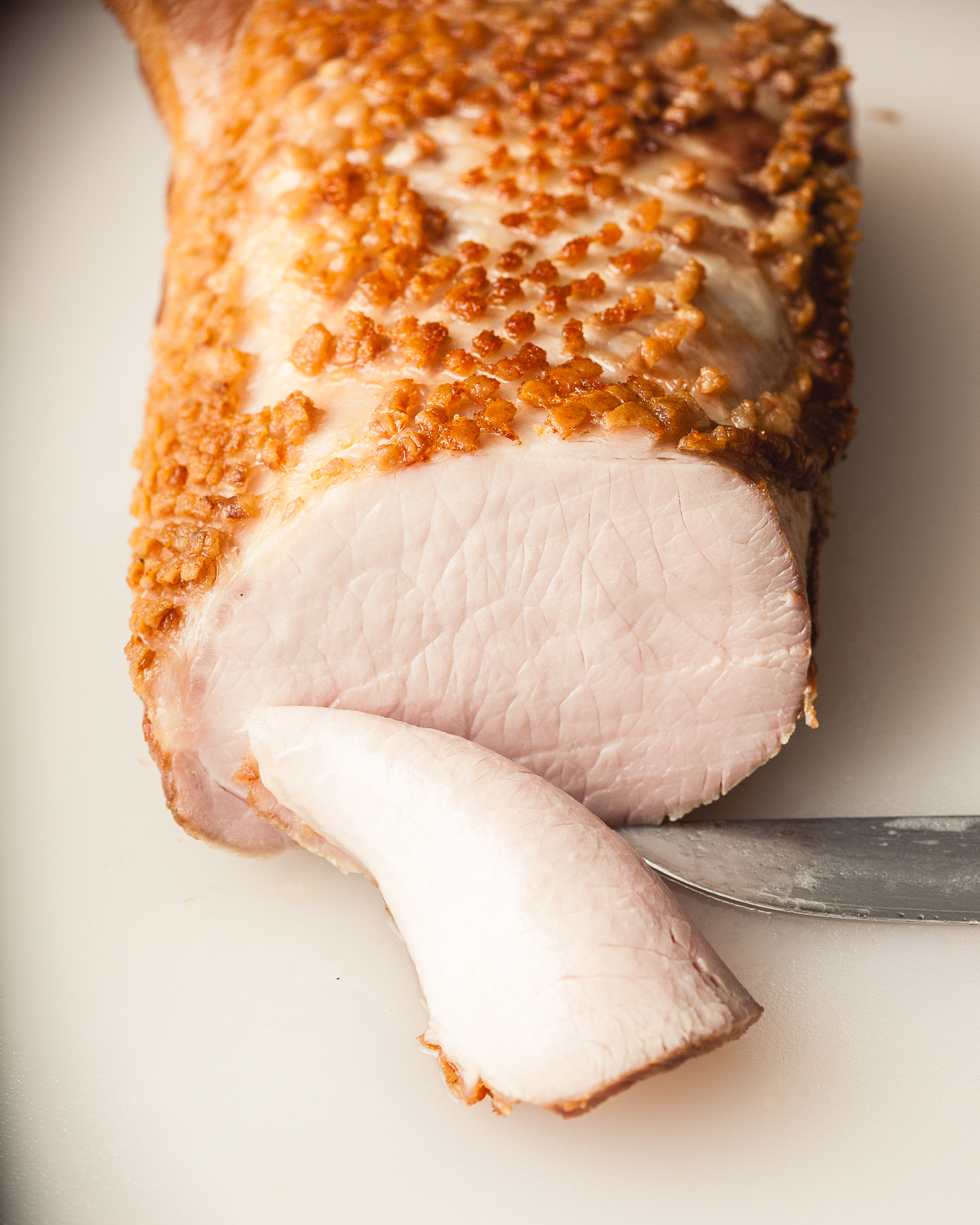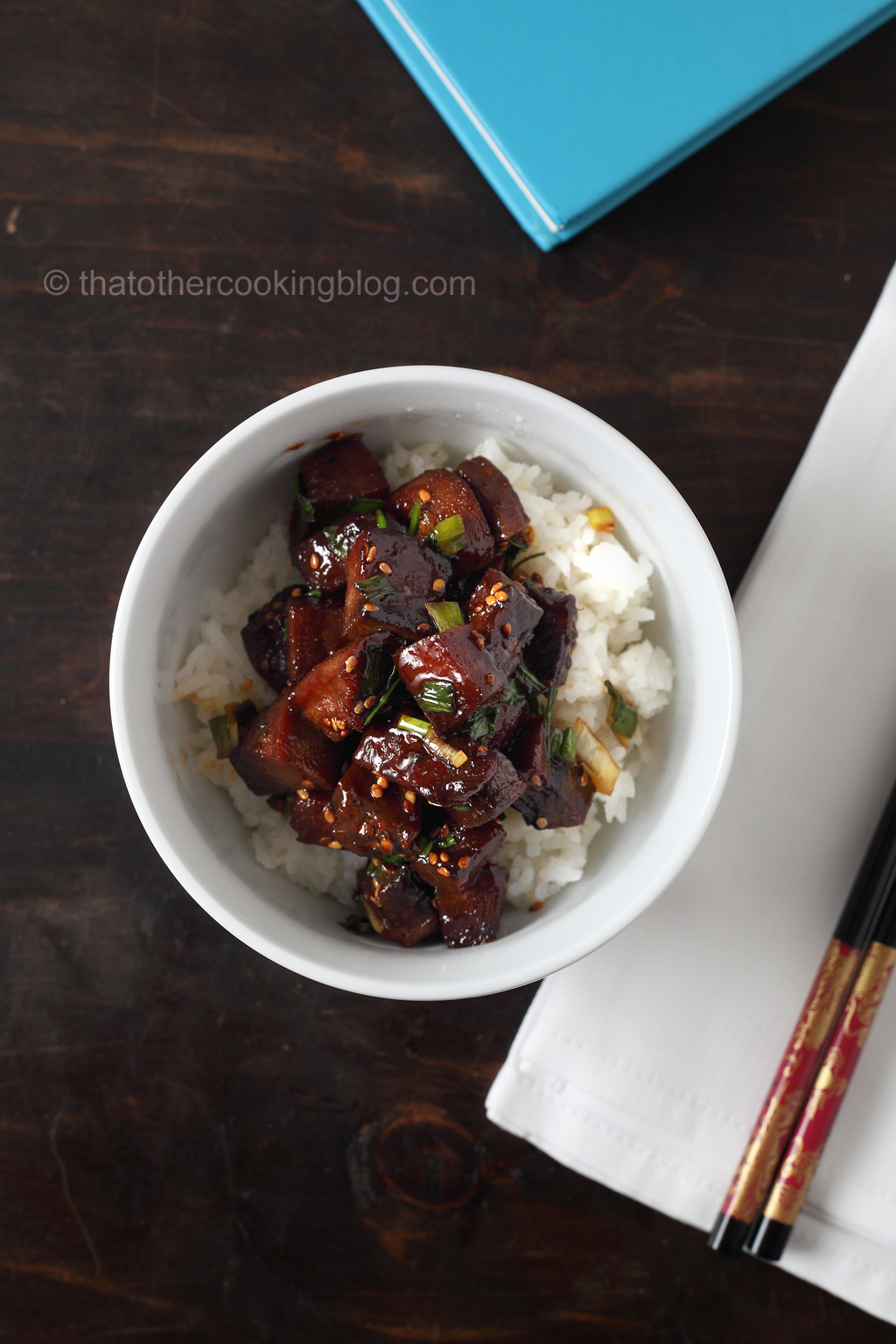If you’ve ever cooked pork loin this way you know it makes a terrific cold-cut. It also makes me wish I owned one of those fancy meat slicers. Since it’s cooked sous vide it’s extremely juicy. Some of that juiciness comes from gelatine/collagen so in order to get extreme juiciness you probably wanna apply some heat. I’ve prepared pork this way in past occasions (see my previous boneless pork centre loin sous vide post) usually sticking to pasteurization-to-core cooking times which are usually less than 12 hours but out of convenience I decided to let it go overnight. I was a little worried the long cooking time would have a negative impact on the texture but to my surprise it was actually an improvement. Another thing worth mentioning is that one if not the most important reason behind me buying this meat was the beautiful fat layer covering the top of it. I had to. There was nothing I could do.
If you have the time, brine brine brine!
This 5%-5% sugar salt brine is pretty basic but that’s my cooking I guess. I keep seasoning of meats pretty simple. Maybe at times I feel all experimental and try spices and stuff but it’s a bit out of character for me. Experiment all you want by all means, you could try honey instead of sugar for example and add acid to the brine like lemon juice, etc. Pepper, juniper berries, star anise, cloves, whiskey, coke, go nuts but if you wanna keep it simple, salt and perhaps sugar it’s all that’s needed to get an amazingly seasoned brined meat.

I like to boil the brine before using and then refrigerating it before using. You could cool it off by adding ice but then you’d have to work out the salt and sugar concentrations to compensate for the added water, it’s all simple math and I’m sure you can all figure it out. Just make sure your brine is pretty cold before you use it. Same with the meat, keep it as cold as you can before brining avoiding of course freezing it unless you really have to. If you bought the meat frozen (which is not ideal but convenient), thaw it before brining or adjust your brining time to compensate for this. If you wanna keep it simple, add an extra day to your brining time.
Criss cross!
Remember that nice fat layer I was talking about? well, a perfect opportunity for crispiness. To facilitate thing during searing I cut the fat layer in a fine criss cross patter similar to what you would do to prepare duck skin for searing. Same concept, increase surface area to speed up fat melting. The rest was now up to hot oil to get the desired effect.

The hotter the better!
And that’s the history of searing. The hotter the better. This causes all kinds of issues in my not so well ventilated kitchen and oversensitive smoke detectors. My workaround is deep frying at 400F but tonight I’m feeling dangerous so I’ll be going 475F by using ghee. The thing about deep frying is that it is smoke-free, very even and fast. The downside, kitchen fires aren’t fun, in fact, they’re extremely dangerous so be careful when trying this. If you have a grill and the luxury of a yard, I would suggest heating your grill to as hot as it gets and searing stuff that way. More traditional methods of searing are ok, but generate smoke and I don’t like burning oil. It changes the flavor of it and not in a good way. Ghee is a much better fat for shallow pan searing.
Remember to rest the meat to rest before slicing and serving, keep those knives razor sharp and that’s it! Take care guys!

Wanna get more sous-vide cooking guides and cool cooking how-to’s in your mailbox? You know what needs to be done!
We never spam. You should only be getting updates when new content is posted on the site. We also respect your privacy. We don’t share your email address with anyone and you can unsubscribe anytime!





19 comments
Hi Paul, I’d say sear pork in lard. A high smoke point like ghee, but more porky. 12 hours 57C sounds perfect for pork loin. You could easily thaw in the brine. I am more in favor of dry cures than wet and of calculating the amount of salt so that the brining time won’t make a difference.
oh my god! it’s been so long since I seared with lard and my mom used to cook with it all the time I should revisit you’re right! I’ve done both wet and dry but gravitate towards wet brines. I haven’t measured weight after wet brines but I believe meat does indeed absorb brine water which might help with juiciness. I mean, you’re way more technical at this stuff, let me know what you think. Glad to hear from you!
PS that sear does look great!
hahah thanks! 🙂
Hi Paul, the loin looks great! What are your salt/sugar/water measurements for your basic 5% brine. Thanks, Jack
Hey Jack, thanks! Just do 50 grams of salt and 50 grams of sugar for every litre of water (1000g) Make enough brine to submerge the loin. The math isn’t exact but it’s pretty close. I’m planning on writing about proper % calculations 🙂
do you change time of brine ?
Brining for 48 hours is pretty safe if you’re using a pasteurized brine (boiled). Not sure that answers your question. Let me know.
do you brine all your meat? and if yes ,will be the same brine?
usually brine larger cuts/whole birds. If I have time I do or I dry cure it in a similar way. The brine is about the same in terms of salt concentration but sometimes I add sugar, spices, fruit juices, wines, etc… it really depends and its based on taste more than anything else 🙂
Gorgeous. I love seeing Stefan’s input, too. He’s the reason I knew I really wanted a sous vide. It just took my husband a few years to be convinced. It’s an incredible machine.
yeah, he’s taught me a lot!
you sear it only with Ghee? or you add smething?
Hi Uri, just use ghee! If you don’t have that, then simple use any oil with a high smoke point. Lard will work too.
hi again
i will use the ghee for the first time.
i am curious if i will put it on beef meat without fat . did yo try it ?
do you mean lean beef? ghee should work with or without beef fat 🙂
you get a wonderful colour and texture . i hope that i can get it on a lean beef .
you should 🙂 get the ghee pretty hot, around 450F and be careful!